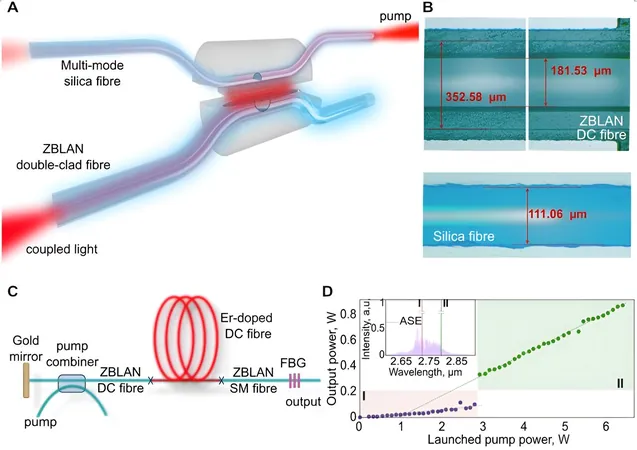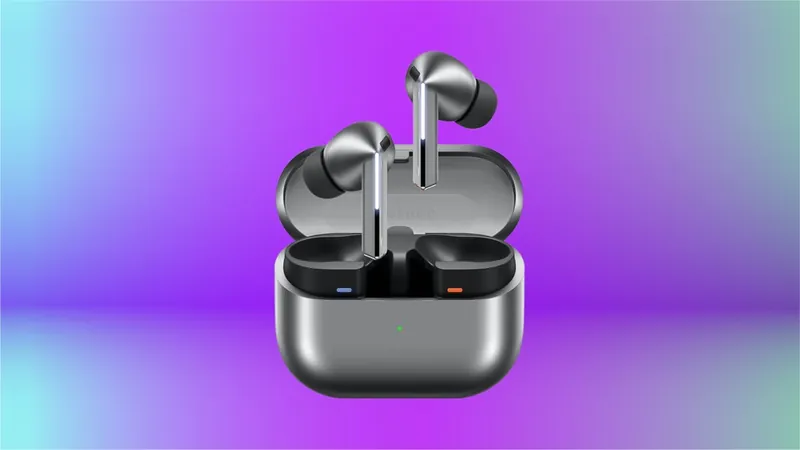
Groundbreaking Hybrid Fiber Pump Combiner Set to Revolutionize Mid-IR Laser Technology!
2024-10-09
Author: Jacob
Introduction
In recent years, the quest for innovative mid-infrared (mid-IR) light sources has surged, fueled by their crucial applications in diverse fields such as environmental monitoring, medical diagnostics, and global positioning systems. Fiber-based mid-IR lasers, particularly those operating beyond 2.5 µm, are emerging as frontrunners, known for their high brightness capabilities. However, expanding laser generation into the mid-IR spectrum comes with formidable challenges, primarily rooted in the high absorption rates characteristic of silica fibers. This challenge arises from the elevated phonon energy within glass matrices.
Limitations of Traditional Methods
To tackle these issues, scientists have increasingly turned to soft glass fibers, which present their own set of complications. These fibers necessitate a comprehensive overhaul of conventional fiber laser development methods due to their properties, which include high thermal expansion, low melting points, and inherent fragility. As a result, most existing mid-IR fiber laser systems predominantly utilize bulk components, with fibers acting solely as the gain medium.
Breakthrough Innovation
In a significant breakthrough, a research team led by Dr. Maria Chernysheva at the Leibniz Institute of Photonic Technology has unveiled a pioneering hybrid fiber pump combiner, a critical advancement essential for the efficiency of all-fiber laser systems. Highlighting the current predicament, the authors emphasize that "the integration of pump lasers—traditionally linked with silica fiber outputs—into mid-IR fiber laser systems faces significant hurdles." The difference in thermal properties between silica and soft glass fibers, like fluoride glass—which possesses nearly half the melting point and 30 times the thermal expansion coefficient of silica—has made traditional splicing methods exceptionally challenging, rendering the creation of fused hybrid fiber components nearly impossible.
However, the research team has turned this challenge into an opportunity by exploring a side coupling approach using the evanescent field. By meticulously polishing the fibers over a length of approximately 1 cm and aligning them alongside each other, the researchers achieved an impressive coupling efficiency exceeding 80%, all without the need for direct splicing. This innovative technique effectively harnesses the evanescent field to facilitate light transfer from silica pump fibers into fluoride signal fibers, successfully overcoming the limitations posed by the characteristics of soft glass fibers.
Remarkable Outcomes
One of the most remarkable outcomes of this new design is its ability to distribute heat evenly across an enlarged polished fiber area. This advancement enables the system to operate at high power levels with outstanding long-term stability measured at an RMS of only 0.09%. The team reported that the excess losses recorded were less than 0.9 dB, a performance level that rivals commercially available silica fiber-based wavelength division multiplexers (WDMs) even at longer signal wavelengths.
Versatility and Applications
What’s more, this pioneering design is remarkably versatile, allowing for a variety of fiber types—be they active or passive—to be utilized within the combiner setup, and it can adapt seamlessly to different types of glass materials or polymer-based optical fibers.
Implications for the Future
The implications of this research are profound. The team concludes that their work heralds a new era for mid-IR all-fiber lasers, ushering in significant improvements over traditional butt-coupling techniques. This new design not only supports more sophisticated laser configurations and advanced functionalities but also possesses the potential for applications in other components like material saturable absorbers or sensors.
Conclusion
The development of the hybrid fiber pump combiner is a thrilling leap forward that promises to enhance mid-IR laser technology's efficiency and applications, paving the way for future advancements that could revolutionize industries reliant on accurate environmental monitoring, cutting-edge medical diagnostics, and precise global positioning systems. Stay tuned for more exciting updates in the world of photonic innovations!









 Brasil (PT)
Brasil (PT)
 Canada (EN)
Canada (EN)
 Chile (ES)
Chile (ES)
 España (ES)
España (ES)
 France (FR)
France (FR)
 Hong Kong (EN)
Hong Kong (EN)
 Italia (IT)
Italia (IT)
 日本 (JA)
日本 (JA)
 Magyarország (HU)
Magyarország (HU)
 Norge (NO)
Norge (NO)
 Polska (PL)
Polska (PL)
 Schweiz (DE)
Schweiz (DE)
 Singapore (EN)
Singapore (EN)
 Sverige (SV)
Sverige (SV)
 Suomi (FI)
Suomi (FI)
 Türkiye (TR)
Türkiye (TR)